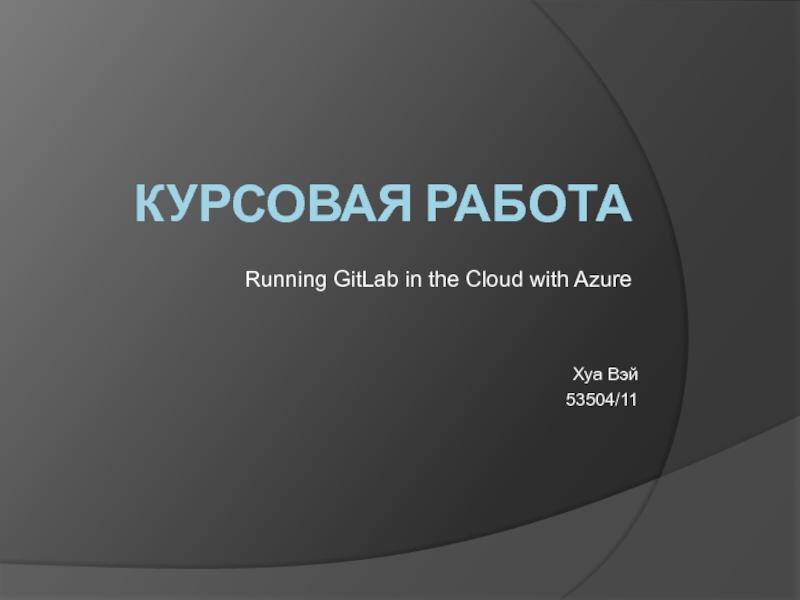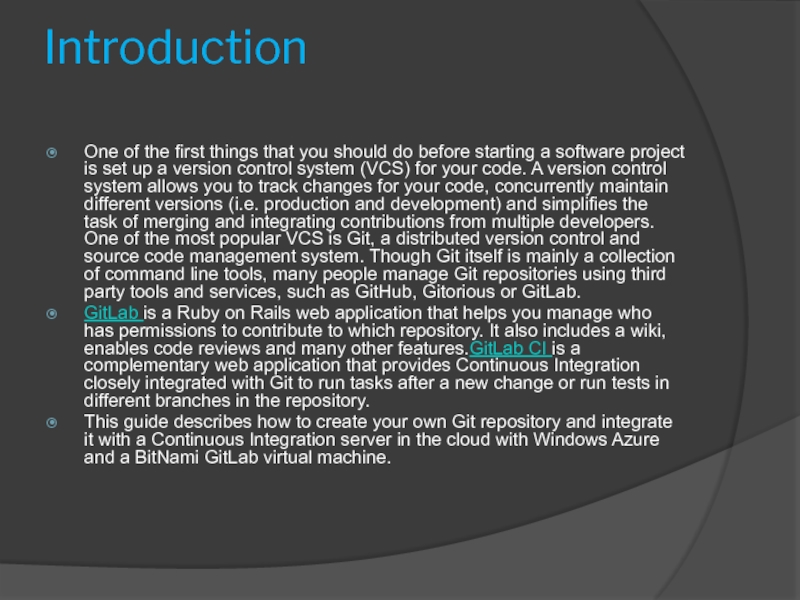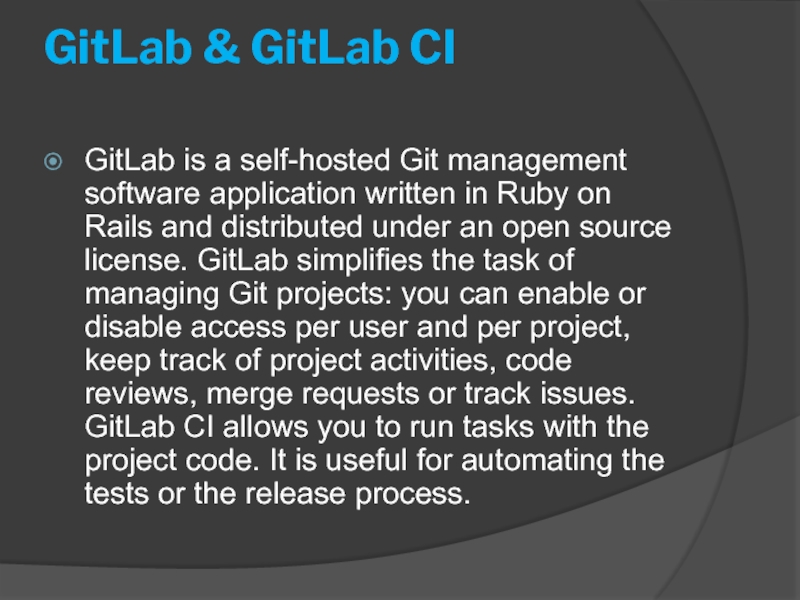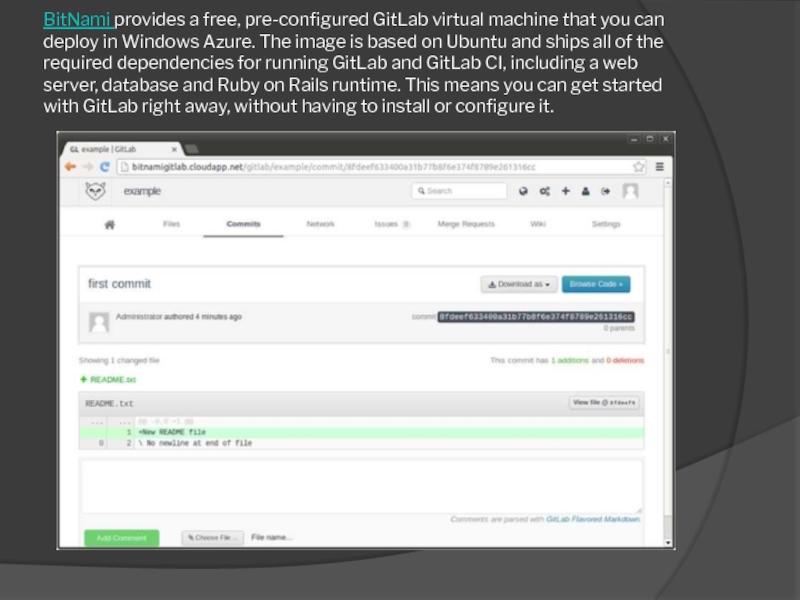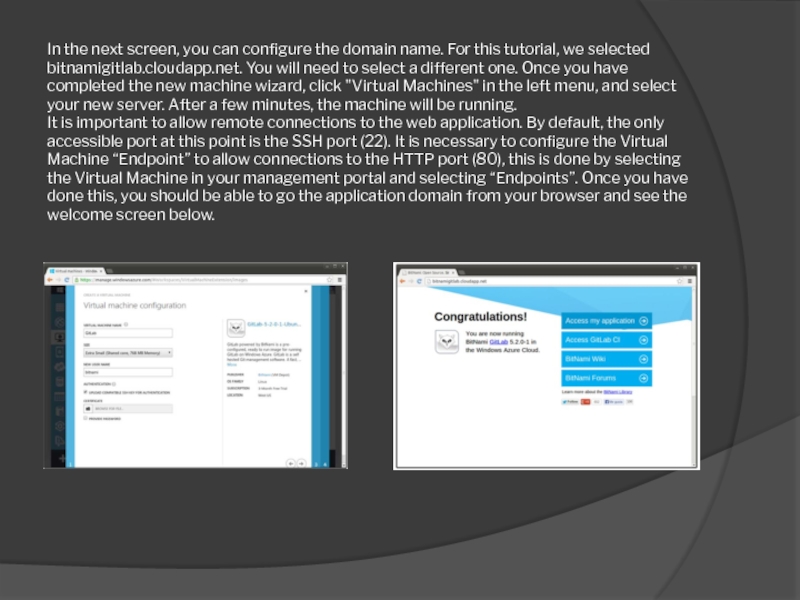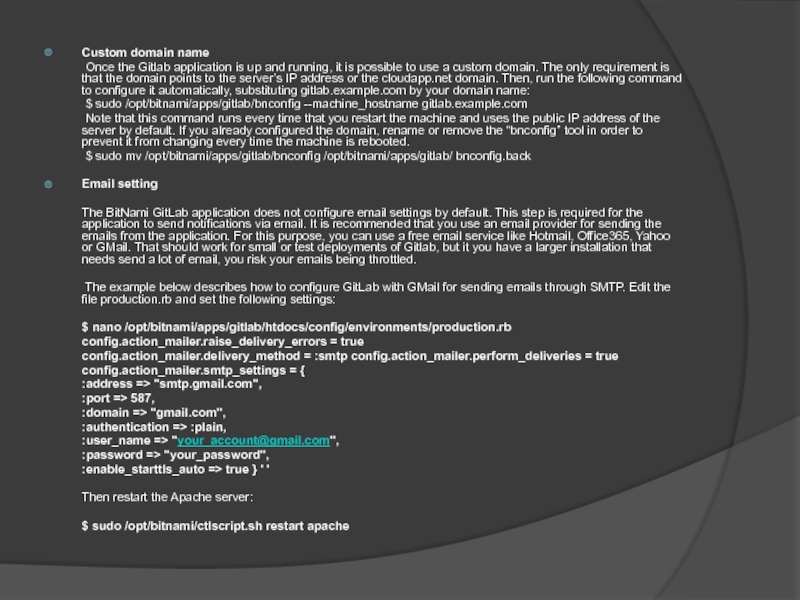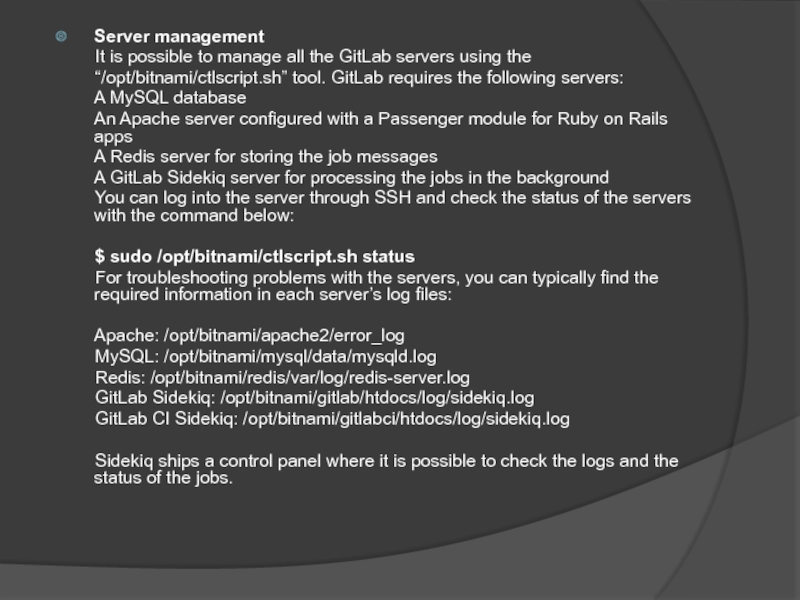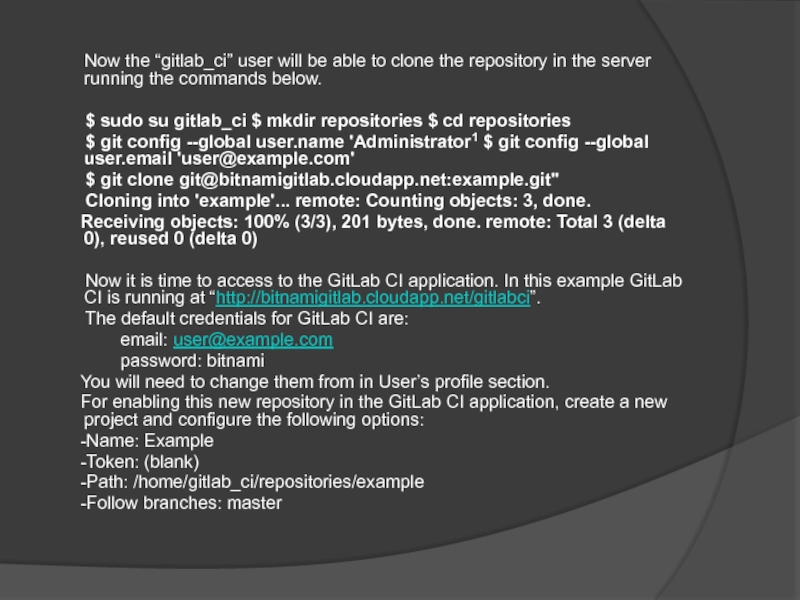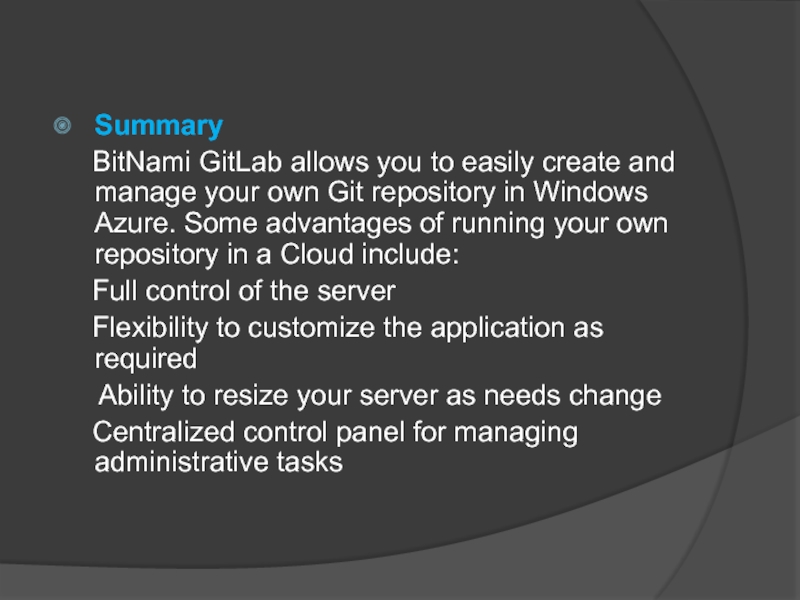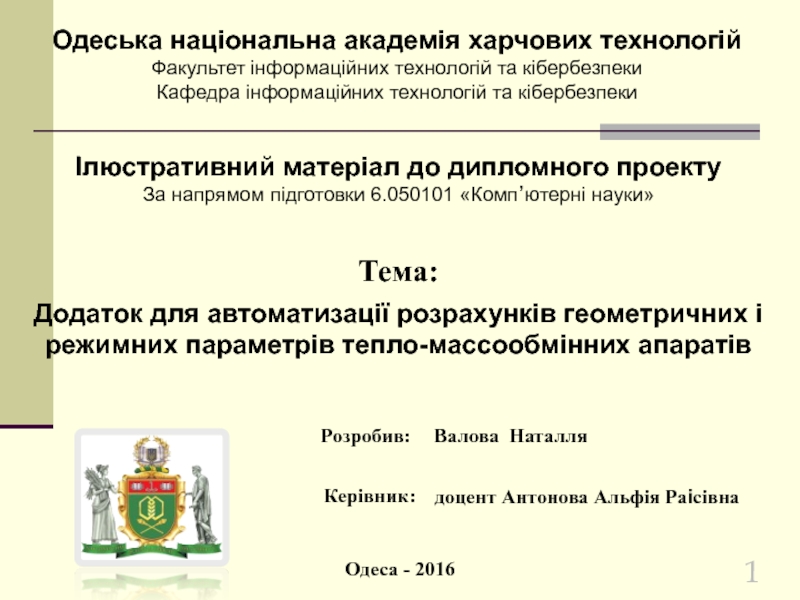- Главная
- Разное
- Дизайн
- Бизнес и предпринимательство
- Аналитика
- Образование
- Развлечения
- Красота и здоровье
- Финансы
- Государство
- Путешествия
- Спорт
- Недвижимость
- Армия
- Графика
- Культурология
- Еда и кулинария
- Лингвистика
- Английский язык
- Астрономия
- Алгебра
- Биология
- География
- Детские презентации
- Информатика
- История
- Литература
- Маркетинг
- Математика
- Медицина
- Менеджмент
- Музыка
- МХК
- Немецкий язык
- ОБЖ
- Обществознание
- Окружающий мир
- Педагогика
- Русский язык
- Технология
- Физика
- Философия
- Химия
- Шаблоны, картинки для презентаций
- Экология
- Экономика
- Юриспруденция
Running GitLab in the Cloud with Azure презентация
Содержание
- 1. Running GitLab in the Cloud with Azure
- 2. Introduction One of the first things
- 3. GitLab & GitLab CI GitLab is
- 4. BitNami provides a free, pre-configured GitLab virtual
- 5. If you complete the process outlined previously
- 6. In the next screen, you can configure
- 7. How to create a Git repository in
- 8. Custom domain name
- 9. Configuring GitLab Managing projects from the
- 10. Server management It
- 11. How to integrate GitLab & GitLab CI
- 12. Now the “gitlab_ci”
- 13. Once created, click on the “Details” tab
- 14. Summary BitNami GitLab allows you
Слайд 2Introduction
One of the first things that you should do before starting
a software project is set up a version control system (VCS) for your code. A version control system allows you to track changes for your code, concurrently maintain different versions (i.e. production and development) and simplifies the task of merging and integrating contributions from multiple developers. One of the most popular VCS is Git, a distributed version control and source code management system. Though Git itself is mainly a collection of command line tools, many people manage Git repositories using third party tools and services, such as GitHub, Gitorious or GitLab.
GitLab is a Ruby on Rails web application that helps you manage who has permissions to contribute to which repository. It also includes a wiki, enables code reviews and many other features.GitLab CI is a complementary web application that provides Continuous Integration closely integrated with Git to run tasks after a new change or run tests in different branches in the repository.
This guide describes how to create your own Git repository and integrate it with a Continuous Integration server in the cloud with Windows Azure and a BitNami GitLab virtual machine.
GitLab is a Ruby on Rails web application that helps you manage who has permissions to contribute to which repository. It also includes a wiki, enables code reviews and many other features.GitLab CI is a complementary web application that provides Continuous Integration closely integrated with Git to run tasks after a new change or run tests in different branches in the repository.
This guide describes how to create your own Git repository and integrate it with a Continuous Integration server in the cloud with Windows Azure and a BitNami GitLab virtual machine.
Слайд 3GitLab & GitLab CI
GitLab is a self-hosted Git management software application
written in Ruby on Rails and distributed under an open source license. GitLab simplifies the task of managing Git projects: you can enable or disable access per user and per project, keep track of project activities, code reviews, merge requests or track issues. GitLab CI allows you to run tasks with the project code. It is useful for automating the tests or the release process.
Слайд 4BitNami provides a free, pre-configured GitLab virtual machine that you can
deploy in Windows Azure. The image is based on Ubuntu and ships all of the required dependencies for running GitLab and GitLab CI, including a web server, database and Ruby on Rails runtime. This means you can get started with GitLab right away, without having to install or configure it.
Слайд 5If you complete the process outlined previously short wizard, you will
now have the GitLab image in your “Images” section. Select it and click on the "Register" button.
Once the new image is added available, click on “New” in the left bottom corner. Select "Virtual Machine" and then the "From Gallery" option. Go to "My Images" in the new pop-up window and select your new image.
Слайд 6In the next screen, you can configure the domain name. For
this tutorial, we selected bitnamigitlab.cloudapp.net. You will need to select a different one. Once you have completed the new machine wizard, click "Virtual Machines" in the left menu, and select your new server. After a few minutes, the machine will be running.
It is important to allow remote connections to the web application. By default, the only accessible port at this point is the SSH port (22). It is necessary to configure the Virtual Machine “Endpoint” to allow connections to the HTTP port (80), this is done by selecting the Virtual Machine in your management portal and selecting “Endpoints”. Once you have done this, you should be able to go the application domain from your browser and see the welcome screen below.
Слайд 7How to create a Git repository in GitLab
The default Admin credentials
for GitLab are:
Username: user
Password: bitnami
You should change these default values right away. You can change the password and the email in the “User’s Profile” section, where you can also upload your public SSH key. This key will be necessary to push the code into the repository and it will be also required for all new users that need privileges to modify the code.
You can upload your project files to the GitLab repository by following the steps above. It is important to copy your private key in the SSH folder according to your platform:
For Windows: "C:\Users\user_name\.ssh\id_rsa"
For Linux: "/home/user_name/.ssh/id_rsa"
For OS X: "/Users/user_name/.ssh/id_rsa"
Username: user
Password: bitnami
You should change these default values right away. You can change the password and the email in the “User’s Profile” section, where you can also upload your public SSH key. This key will be necessary to push the code into the repository and it will be also required for all new users that need privileges to modify the code.
You can upload your project files to the GitLab repository by following the steps above. It is important to copy your private key in the SSH folder according to your platform:
For Windows: "C:\Users\user_name\.ssh\id_rsa"
For Linux: "/home/user_name/.ssh/id_rsa"
For OS X: "/Users/user_name/.ssh/id_rsa"
Слайд 8Custom domain name
Once the Gitlab
application is up and running, it is possible to use a custom domain. The only requirement is that the domain points to the server’s IP address or the cloudapp.net domain. Then, run the following command to configure it automatically, substituting gitlab.example.com by your domain name:
$ sudo /opt/bitnami/apps/gitlab/bnconfig --machine_hostname gitlab.example.com
Note that this command runs every time that you restart the machine and uses the public IP address of the server by default. If you already configured the domain, rename or remove the “bnconfig” tool in order to prevent it from changing every time the machine is rebooted.
$ sudo mv /opt/bitnami/apps/gitlab/bnconfig /opt/bitnami/apps/gitlab/ bnconfig.back
Email setting
The BitNami GitLab application does not configure email settings by default. This step is required for the application to send notifications via email. It is recommended that you use an email provider for sending the emails from the application. For this purpose, you can use a free email service like Hotmail, Office365, Yahoo or GMail. That should work for small or test deployments of Gitlab, but it you have a larger installation that needs send a lot of email, you risk your emails being throttled.
The example below describes how to configure GitLab with GMail for sending emails through SMTP. Edit the file production.rb and set the following settings:
$ nano /opt/bitnami/apps/gitlab/htdocs/config/environments/production.rb
config.action_mailer.raise_delivery_errors = true
config.action_mailer.delivery_method = :smtp config.action_mailer.perform_deliveries = true
config.action_mailer.smtp_settings = {
:address => "smtp.gmail.com",
:port => 587,
:domain => "gmail.com",
:authentication => :plain,
:user_name => "your_account@gmail.com",
:password => "your_password",
:enable_starttls_auto => true } ' '
Then restart the Apache server:
$ sudo /opt/bitnami/ctlscript.sh restart apache
$ sudo /opt/bitnami/apps/gitlab/bnconfig --machine_hostname gitlab.example.com
Note that this command runs every time that you restart the machine and uses the public IP address of the server by default. If you already configured the domain, rename or remove the “bnconfig” tool in order to prevent it from changing every time the machine is rebooted.
$ sudo mv /opt/bitnami/apps/gitlab/bnconfig /opt/bitnami/apps/gitlab/ bnconfig.back
Email setting
The BitNami GitLab application does not configure email settings by default. This step is required for the application to send notifications via email. It is recommended that you use an email provider for sending the emails from the application. For this purpose, you can use a free email service like Hotmail, Office365, Yahoo or GMail. That should work for small or test deployments of Gitlab, but it you have a larger installation that needs send a lot of email, you risk your emails being throttled.
The example below describes how to configure GitLab with GMail for sending emails through SMTP. Edit the file production.rb and set the following settings:
$ nano /opt/bitnami/apps/gitlab/htdocs/config/environments/production.rb
config.action_mailer.raise_delivery_errors = true
config.action_mailer.delivery_method = :smtp config.action_mailer.perform_deliveries = true
config.action_mailer.smtp_settings = {
:address => "smtp.gmail.com",
:port => 587,
:domain => "gmail.com",
:authentication => :plain,
:user_name => "your_account@gmail.com",
:password => "your_password",
:enable_starttls_auto => true } ' '
Then restart the Apache server:
$ sudo /opt/bitnami/ctlscript.sh restart apache
Слайд 9Configuring GitLab
Managing projects from the GitLab application is extremely easy. From
the “Admin” panel it is possible to add new users or to create teams and groups with different permissions within a projects.
GitLab projects can be set up as public too. That means that any user has read access for that project and is able to clone the project with the command below.
$ git clone http://bitnamigitlab.cloudapp.net/gitlab/example.git
GitLab projects can be set up as public too. That means that any user has read access for that project and is able to clone the project with the command below.
$ git clone http://bitnamigitlab.cloudapp.net/gitlab/example.git
Слайд 10Server management
It is possible to manage all
the GitLab servers using the
“/opt/bitnami/ctlscript.sh” tool. GitLab requires the following servers:
A MySQL database
An Apache server configured with a Passenger module for Ruby on Rails apps
A Redis server for storing the job messages
A GitLab Sidekiq server for processing the jobs in the background
You can log into the server through SSH and check the status of the servers with the command below:
$ sudo /opt/bitnami/ctlscript.sh status
For troubleshooting problems with the servers, you can typically find the required information in each server’s log files:
Apache: /opt/bitnami/apache2/error_log
MySQL: /opt/bitnami/mysql/data/mysqld.log
Redis: /opt/bitnami/redis/var/log/redis-server.log
GitLab Sidekiq: /opt/bitnami/gitlab/htdocs/log/sidekiq.log
GitLab CI Sidekiq: /opt/bitnami/gitlabci/htdocs/log/sidekiq.log
Sidekiq ships a control panel where it is possible to check the logs and the status of the jobs.
“/opt/bitnami/ctlscript.sh” tool. GitLab requires the following servers:
A MySQL database
An Apache server configured with a Passenger module for Ruby on Rails apps
A Redis server for storing the job messages
A GitLab Sidekiq server for processing the jobs in the background
You can log into the server through SSH and check the status of the servers with the command below:
$ sudo /opt/bitnami/ctlscript.sh status
For troubleshooting problems with the servers, you can typically find the required information in each server’s log files:
Apache: /opt/bitnami/apache2/error_log
MySQL: /opt/bitnami/mysql/data/mysqld.log
Redis: /opt/bitnami/redis/var/log/redis-server.log
GitLab Sidekiq: /opt/bitnami/gitlab/htdocs/log/sidekiq.log
GitLab CI Sidekiq: /opt/bitnami/gitlabci/htdocs/log/sidekiq.log
Sidekiq ships a control panel where it is possible to check the logs and the status of the jobs.
Слайд 11How to integrate GitLab & GitLab CI
This section explains how to
fully integrate GitLab and GitLab CI for running tasks automatically. This example will cover how to run the unit tests of a Ruby on Rails project, Redmine.
It is necessary to create a public and private key for the “gitlab_ci” user in the server, so this user will have read access to the chosen repositories. Once logged in the server through SSH, run the following command and do not specify any password for the key:
$ sudo su gitlab_ci -c "ssh-keygen -t rsa"
Then read the new public key and copy the contents in a file. GitLab will give read-only privileges to this user account.
In GitLab, go to the project “Settings” and add a new “Deploy Key”. Then copy the public key created previously. When you copy the key, make sure the key content does not contain newlines.
It is necessary to create a public and private key for the “gitlab_ci” user in the server, so this user will have read access to the chosen repositories. Once logged in the server through SSH, run the following command and do not specify any password for the key:
$ sudo su gitlab_ci -c "ssh-keygen -t rsa"
Then read the new public key and copy the contents in a file. GitLab will give read-only privileges to this user account.
In GitLab, go to the project “Settings” and add a new “Deploy Key”. Then copy the public key created previously. When you copy the key, make sure the key content does not contain newlines.
Слайд 12 Now the “gitlab_ci” user will be able
to clone the repository in the server running the commands below.
$ sudo su gitlab_ci $ mkdir repositories $ cd repositories
$ git config --global user.name 'Administrator1 $ git config --global user.email 'user@example.com'
$ git clone git@bitnamigitlab.cloudapp.net:example.git"
Cloning into 'example'... remote: Counting objects: 3, done.
Receiving objects: 100% (3/3), 201 bytes, done. remote: Total 3 (delta 0), reused 0 (delta 0)
Now it is time to access to the GitLab CI application. In this example GitLab CI is running at “http://bitnamigitlab.cloudapp.net/gitlabci”.
The default credentials for GitLab CI are:
email: user@example.com
password: bitnami
You will need to change them from in User’s profile section.
For enabling this new repository in the GitLab CI application, create a new project and configure the following options:
-Name: Example
-Token: (blank)
-Path: /home/gitlab_ci/repositories/example
-Follow branches: master
$ sudo su gitlab_ci $ mkdir repositories $ cd repositories
$ git config --global user.name 'Administrator1 $ git config --global user.email 'user@example.com'
$ git clone git@bitnamigitlab.cloudapp.net:example.git"
Cloning into 'example'... remote: Counting objects: 3, done.
Receiving objects: 100% (3/3), 201 bytes, done. remote: Total 3 (delta 0), reused 0 (delta 0)
Now it is time to access to the GitLab CI application. In this example GitLab CI is running at “http://bitnamigitlab.cloudapp.net/gitlabci”.
The default credentials for GitLab CI are:
email: user@example.com
password: bitnami
You will need to change them from in User’s profile section.
For enabling this new repository in the GitLab CI application, create a new project and configure the following options:
-Name: Example
-Token: (blank)
-Path: /home/gitlab_ci/repositories/example
-Follow branches: master
Слайд 13Once created, click on the “Details” tab because the “Project URL”
and “Project Token” are required for the next step.
GitLab requires these settings for finishing the integration. Go to the GitLab project settings and configure GitLab CI in the “Services” tab. Fill "Project URL" and "Project Token" with the values from the previous step and press “Save”. This is the last step for integrating both applications.
Слайд 14Summary
BitNami GitLab allows you to easily create and manage
your own Git repository in Windows Azure. Some advantages of running your own repository in a Cloud include:
Full control of the server
Flexibility to customize the application as required
Ability to resize your server as needs change
Centralized control panel for managing administrative tasks
Full control of the server
Flexibility to customize the application as required
Ability to resize your server as needs change
Centralized control panel for managing administrative tasks
